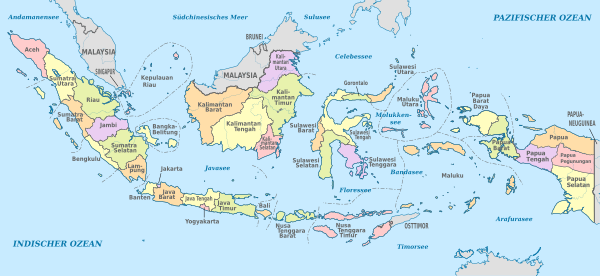Administrative division of Indonesia
The Republic of Indonesia is divided into 31 provinces , two special regions and the capital district Jakarta . Administrative districts and cities directly subordinate to the provinces form a second administrative level. This is followed by the districts and finally the villages.
Provinces, Special Regions and the Capital District
Indonesia consists of 31 provinces ( Propinsi ), the two special regions ( Daerah Istimewa ) Aceh and Yogyakarta and the capital district (Daerah Khusus Ibukota) Jakarta . With the exception of Yogyakarta, there is always an elected governor. He and the regional parliament (Dewan Perwakilan Rakyat Daerah) are re-elected every five years.
The youngest provinces of Indonesia were created by secession. They are: Papua Barat (West Papua, 2003 by Papua split), Sulawesi Barat (Westcelebes, 2004 Südcelebes split off) and Kalimantan Utara (North Borneo, 2012 by Ostborneo split).
Aceh has greater autonomy from the central government. Here the Islamic law of Sharia was introduced.
In Yogyakarta the office of governor is exercised by the respective Sultan of Yogyakarta, the Hamengkubuwono in hereditary monarchy. The partial autonomy of Yogyakarta and the special regulation for the sultan in the governorship were last confirmed by a national law in August 2012. Accordingly, the sultan is not allowed to belong to any political party.
The governor of Jakarta Capital District can appoint and dismiss subordinate mayors of cities. In addition, the government is allowed to enter into direct cooperation with cities in other countries.
Administrative districts and cities
At the level below the provinces there are 416 administrative districts ( Kabupaten ), which have been of great administrative importance since the administrative reform in 2001. The 98 provincial towns (Kota) are on the same level of structure .
The government districts are headed by a district president ( Bupati ) , and the cities by a mayor (Walikota). They and the local parliaments are elected by the people every five years.
Districts
Administrative districts and cities are divided into districts ( Kecamatan ). They are headed by the civil servant district chief ( Camat ) , who is subordinate to the administrative district or the city. In the Indonesian provinces in Western New Guinea , Law 21 of 2001 refers to the districts as the districts and the heads as the Kepala districts . The number of districts rose steadily, in 2015 the number was 7,094, in 2016 there were 7,070 and a year later there were already 7144 and 7145 Kecamatan.
Prior to the establishment of the Republic of Indonesia, a camat was a senior Javanese official of noble origin. Thus, like the title Bupati , this designation goes back to former aristocratic nobility titles that were adopted by the Republic of Indonesia.
Villages
The villages form the lowest level of the administrative units. They can consist of several localities or just districts. The Indonesian names for this level vary depending on the status and geographical location, with the term Desa (village) being used in overall overviews . In 2015 there were 82,505 Desa. Various sources give the number of villages for 2016 as 81,430 and for 2017 as 82,395 and 82,405.
Desas in Aceh are called Gampong , in New Guinea, in parts of Kalimantan and in Lampung as Kampung, Pekon in Lampung and in West Sumatra as Nagari .
Kelurahans are at the same administrative level as Desas, but have less autonomy from the counties and cities to which they belong. Their heads (Lurah) are appointed while the heads of the Desas (Kepala Desa) are elected.
In Aceh there is still the Mukim as a subdivision of the districts . This brings together several villages (Gampong) .
Names
Many administrative units are named after their geographical location:
- Barat = west
- Barat Daya = southwest
- Besar = large
- Kecil = small
- Kepulauan = islands, archipelago
- Loud = sea
- Pulau = island
- Pulau-Pulau = islands
- Selatan = south
- Timur = east
- Tengah = central
- Tenggara = southeast
- Utara = north
See also
Web links
- List of the administrative units of Indonesia down to the Desas as the lowest unit - Census 2010 ( Memento from March 27, 2014 in the Internet Archive ) (Indonesian; PDF; 6.0 MB); the same list in English
- - Current database (Tahun 2017 ) of the administrative hierarchy up to the Desa with search and sort function as well as the codes; Indonesian
- MFD Online - to search for administrative units; Indonesian
Individual evidence
- ↑ List of the administrative units of Indonesia down to the Desas 2010 ( Memento of March 27, 2014 in the Internet Archive ) (Indonesian; PDF; 6.0 MB)
- ^ Neue Zürcher Zeitung: The Sultanate of Yogyakarta evades democratization , July 9, 2013 , accessed on July 14, 2013
- ^ Undang-Undang Republic of Indonesia Nomor 21 Tahun 2001 .
- ↑ a b http://www.nomor.net/
- ↑ http://hortikultura2.pertanian.go.id/sipedas/tahun/index
- ↑ Penduduk Indonesia menurut desa SP2010 (Indonesian) ( Memento from March 27, 2014 in the Internet Archive ) (PDF; 6.0 MB), accessed on July 14, 2013
- ↑ Qanun Provinsi Nanggroe Aceh Darussalam Nomor 4 Tahun 2003 (PDF; 38 kB)
